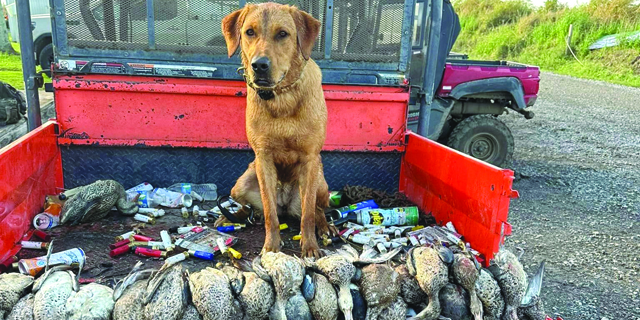Lowest number of ducks ever for early November in Louisiana
Published 12:30 pm Tuesday, November 12, 2024

- As this post-duck hunt photo proves Nov. 9, most of the ducks available on opening day in the West Zone were concentrated around Gueydan, Pecan Island, Klondike and Lake Arthur, according to the aerial waterfowl survey conducted Nov. 4-8 by the Louisiana Department of Wildlife and Fisheries. The fox red Labrador retriever, Bailey, above, did a magnificent job fetching downed ducks for its owner, Austin Theriot, who hunted with friends near Wright, which is just east of Gueydan. facebook.com
BATON ROUGE – Results from the state’s first aerial waterfowl survey of the 2024-25 season won’t surprise many duck hunters who hunted opening weekend on Nov. 9-10 in the West Zone.
Veteran Louisiana Department of Wildlife and Fisheries waterfowl biologist Jason Olszak and his staff flew the survey Nov.4-8. The biologists counted an estimated 510,000 ducks, the lowest number of ducks on record in the state’s coastal region and Little River Basin the week before opening day in the Sportsman’s Paradise.
And, Olszak reported in a prepared statement released Nov. 9 the duck population here was 12.7 percent lower than last November’s previous record low estimate of 584,000, 37 percent lower than the most recent 5-year average (809,000) and 58 percent lower than the most recent 10-year average (1.2 million).
Trending
Plus, he wrote in his report, increases from this month compared to 2023 were only for blue-winged teal (48.7 percent) and pintail (44.9 percent). He noted all other species regularly and historically reported showed annual declines of more than 20 percent.
However, black-bellied whistling ducks, a species that isn’t included in the monthly aerial waterfowl surveys, are down here in great numbers. Olszak estimated there were 107,000 black-bellied whistling ducks across the coast, a 600 percent increase from the 15,000 estimated in 2023.
Also, the waterfowl biologist wrote, three-quarter of the ducks across the coast were in southwest Louisiana.
The recent survey was delayed a few times during the week by inclement weather, Olszak reported.
Olszak said he had a feeling as they started the flights he might see a few more ducks than last November but wouldn’t be surprised if there were less. While habitat conditions are improved, particularly in the marsh, weather conditions were unfavorable.
“Obviously, the numbers were pretty disappointing. But I guess it’s kind of to be expected because we haven’t had many cold fronts. The week we did the survey it was between 80-90 degrees. Hopefully, we’ll get weather to push the birds down,” he said the morning of Nov. 11.
Trending
The large numbers of blue-winged teal and pintail reflect that balmy weather, he noted, because typically it takes cold fronts to prompt green-wings and gadwall, plus divers, to migrate farther South.
“So, hopefully, fall and winter will finally arrive and we’ll get some of those,” Olszak said.
Southwest Louisiana’s blue-winged teal population led the way in the region with 146,000, according to the surveyors. There were 68,000 gadwall and 26,000 green-winged teal in the region.
Olszak and staff counted 21,000 pintail, 10,000 mottled ducks and the same number of shovelers, and only 3,000 wigeon in southwest Louisiana, where there were less than 1,000 mallards.
“The largest duck concentrations were observed in marsh habitats and the southern end of the rice region near Lake Arthur, Klondike, Pecan Island and Gueydan. Both state and federal refuge properties were holding below average duck numbers,” the state’s waterfowl program manager wrote.
As for the region’s habitat conditions, water levels were slightly below average but variable across the region, he reported, while nuisance floating aquatic plant species were mostly absent, like a linger effect from the severe drought of 2023. Beneficial submerged aquatic vegetation, however, wasn’t widely dispersed across the region, he wrote.
Southwest Louisiana boasted 284,000 total dabbling ducks and zero diving ducks as of the first week of November.
Olszak also broke down the total numbers for 11 major species. Statewide in November 2023, there were 6,000 mallards, compared to 0; 19,000 mottled duck, compared to 15,000 (-21.1 percent); 137,000 gadwall, compared to 87,000 (-36.5 percent); 7,000 wigeon, compared to 3,000 (-57.1 percent); 51,000 green-winged teal, compared to 26,000 (-49.0 percent); 154,000 blue-winged teal, compared to 229,000 (+48.7 percent); 81,000 shoveler, compared to 19,000 (-76.5 percent); 89,000 pintail, compared to 129,000 (+44.9 percent); zero scaup in both ’23 and ’24; 37,000 ringnecks, compared to 2,000 (-94.6 percent), and 3,000 canvasback, compared to 0, for a total 584,000 ducks in 2023 compared to 510,000 (-12.7 percent).
Southeast Louisiana harbored 107,000 ducks during the week before duck hunting opened in Louisiana, according to the latest survey. The majority of them were blue-winged teal, 60,000 of them, followed by 34,000 pintail.
The next aerial waterfowl population survey is scheduled for the week of Dec. 16.




